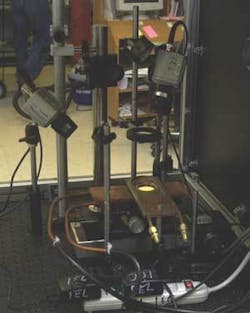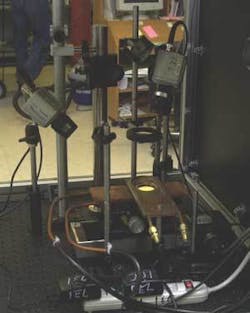FEL heats fat, leaves water alone; could treat acne
In one of those laser-lab developments that show great potential for moving into the wider world, researchers at the Thomas Jefferson National Accelerator Facility (Jefferson Lab; Newport News, VA), Harvard Medical School (Harvard, MA), and the Wellman Center for Photomedicine at Massachusetts General Hospital (Boston, MA) have used the free-electron laser (FEL) at Jefferson Lab to preferentially heat fat in skin-and-fat samples of pig tissue, leaving the other portions relatively unaffacted. The result could one day be safe, effective treatment of acne, cellulite, and even heart disease.
After being held against a cold sapphire window (shown here) to simulate a surgeon’s cold compress, the pig tissue was subjected to the FEL light. While water absorbs more than fat across most of the IR, in the two regions around 1210 and 1720 nm, fat absorbs more. When an average power of 6 to 8 W/cm2 (a total of 30 to 100 W) of 1210 nm light was applied for 16 seconds to the specimen, pig fat up to 1 cm below the skin was preferentially heated. The tunability and power of the FEL made it especially effective in this research; ultimately, though, another type of laser would be designed especially for this application. Contact Fred Dylla at [email protected].

